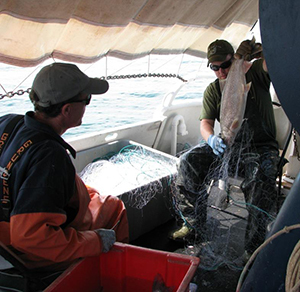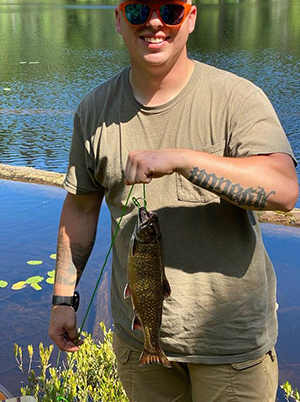Freshwater Fishing & Boating News - September 18th Edition
The New York State Department of Environmental Conservation sent this bulletin on 09/18/2020 10:44 AM EDT |
| DEC Delivers - Information to keep you connected and informed from the NYS Department of Environmental Conservation |
| Share or view as a web page || Update preferences or unsubscribe |
Freshwater Fishing & Boating News - September 18th Edition |
|
This Week's Topics
Lake Erie LakersEvery August, DEC’s Lake Erie Fisheries Research Unit sets gill nets to assess the coldwater fish community. The most common of these species is the lake trout, a predator once native Check back in next week to find out what exciting news this year’s assessment turned up! Fall Tributary Fishing in New York’s Great LakesGreat Lakes tributary fishing can be outstanding in September and October. In Lake Ontario tributaries, Chinook salmon begin showing up in early to mid-September, with Coho salmon, brown trout, and steelhead moving in behind them. Popular fishing locations for Chinook Great Lakes tributary anglers should be mindful in taking precautions to stop the spread of COVID-19 while enjoying the outstanding salmon and trout fishing on Lake Erie and Lake Ontario tributaries. DEC is placing signage at popular locations reminding anglers to be SMART when fishing this year:
For more information about how to PLAY SMART * PLAY SAFE * PLAY LOCAL, visit DEC’s website. Low Water Levels in Salmon RiverThis summer, below-average precipitation has resulted in low and declining water levels in the Salmon River Reservoir. The Executive Committee of the Salmon River Flow Management Team, comprised of natural resource agencies and Brookfield Renewable hydroelectric facility that regulates reservoir water levels, canceled scheduled whitewater releases over the Labor Day weekend and delayed the annual Sept. 1 increase in baseflow. These actions will conserve reservoir water to maintain suitable flows throughout the salmon spawning run. To increase the probability that sufficient numbers of salmon reach the hatchery to sustain the salmon stocking program, DEC will not open the Lower Fly Fishing Section (from County Route 52 Bridge in Altmar upstream 0.25 mile to the marked boundary at Beaverdam Brook) to fishing on Sept. 15. This section will remain closed until DEC collects sufficient numbers of salmon eggs at the hatchery. Protecting New York’s Native Fish SpeciesReclamation is an invaluable tool for the restoration and protection of New York’s native fish species. When non-native fish species like golden shiners and yellow perch are introduced to a water, they can devastate or eliminate native fish populations like brook trout. So, the only way to permanently eliminate non-native species from an entire water body is to apply The Bad News
The Good News The movement of fish by humans can have serious consequences and is a primary reason why the use of bait fish is not permitted in brook trout waters. Be sure to check fishing regulations for the water body you plan on fishing before heading out. DEC Fish Culture Staff Start Fall Domestic Egg CollectionsEach fall, staff from the Catskill and Randolph hatcheries Randolph Hatchery takes nearly 5.5 million eggs from brown, brook and rainbow trout. Rainbow trout normally spawn in the spring, but the rainbows at Randolph are fall spawners. This year a new strain, the Arlee strain, will be used because it’s shown to have a better success rate than the previously used Wytheville strain. Eggs are transferred to DEC’s Van Hornesville Hatchery from the Erwin National Hatchery in Tennessee where they are hatched and raised to yearlings, then transferred to Randolph to be used as broodstock (breeder fish). Also happening this fall, Catskill Hatchery will collect approximately two million brown trout eggs. These eggs are then shipped to other fish hatcheries across New York State to meet production needs for the NYS fish hatchery system. Surplus eggs are also shipped to other state hatcheries such as Vermont, Pennsylvania, Virginia, and Minnesota, along with several county hatcheries in New York when available. |

 to Lake Erie whose populations are now maintained through annual stocking. Prior to stocking, all lake trout receive a coded wire tag implanted into their snout, which can later be recovered by DEC staff to determine the year, strain, and location the fish was stocked. Although lake trout stocking in Lake Erie began in the late 1960’s, it wasn’t until the mid-1980s that populations of stocked adult lake trout (age 5 and older) were found thanks to sea lamprey control. Today, catching an adult lake trout over 30 inches and 15 pounds is not uncommon. In fact, the current
to Lake Erie whose populations are now maintained through annual stocking. Prior to stocking, all lake trout receive a coded wire tag implanted into their snout, which can later be recovered by DEC staff to determine the year, strain, and location the fish was stocked. Although lake trout stocking in Lake Erie began in the late 1960’s, it wasn’t until the mid-1980s that populations of stocked adult lake trout (age 5 and older) were found thanks to sea lamprey control. Today, catching an adult lake trout over 30 inches and 15 pounds is not uncommon. In fact, the current  salmon on Lake Ontario tributaries include the
salmon on Lake Ontario tributaries include the  organic piscicide rotenone, i.e. a reclamation.
organic piscicide rotenone, i.e. a reclamation. conduct the annual fall egg collections for domestic trout stocks. Both facilities use light control to get the fish to spawn earlier in the year than they would naturally. (In the wild, brown trout and brook trout normally don't spawn until November.). This allows fish culturists to get an earlier start in rearing the next year class of trout to be stocked.
conduct the annual fall egg collections for domestic trout stocks. Both facilities use light control to get the fish to spawn earlier in the year than they would naturally. (In the wild, brown trout and brook trout normally don't spawn until November.). This allows fish culturists to get an earlier start in rearing the next year class of trout to be stocked.